Orphan Drugs: Market Overview and Country-Specific Analysis
Orphan medicines have become a formidable R&D segment with robust growth that is expected to continue. Expansion is needed to cope with the issues of development and patient recruitment. An understanding of regulations, therefore, is critical.
"Orphan medicines" are medicinal products intended for treatment of rare diseases. There are currently around 7,000 rare diseases worldwide that affect 350 million patients, 75% of whom are children. Unfortunately, there are no confirmed or approved treatment regimens for 95% of rare diseases and, therefore, very few approved medicinal products have orphan disease indications.
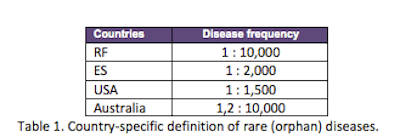
In Europe, a rare disease is defined as a congenital or acquired ailment affecting 1 in 2,000 people. In Russia, according to Article 44 (Part 1) of the Federal Law â 323, dated Nov. 21, 2011, "On the Principles of Citizen's Healthcare in the Russian Federation,” rare diseases are defined as having the prevalence rate of no more than 10 cases per 100,000 population.1 Criteria and definition of rare diseases vary across countries, which is partially illustrated in Table 1. Based onEuropean classification, Russia has somewhere between 1.5 and 5 million patients who suffer from rare diseases (i.e., diseases affecting 1 in 2,000 people).2
Pharmaceutical companies: Orphan drug development is hard to justify
Regulatory authorities are alarmed by the number of rare diseases for which no treatment is available. As the development cycle of an orphan drug doesn't differ from that of a conventional medicine, pharmaceutical companies are frequently forced to apply extreme mark-ups. Thus, a monthly cost of a pharmaceutical product with a rare disease indication is frequently in the thousands and even tens of thousands of dollars.3 And, given that most orphan drugs have to be taken chronically, the lifetime per patient cost can be astronomical.4 At the same time, pharmaceutical companies have not been eager to invest in orphan drug development, as the ROI can be challenging. Therefore, governments and patient advocate organizations have been known to incentivize those pharmaceutical companies that engage in orphan drug development.5 Various administrative, financial, and tax incentives are being offered in a number of developed countries. In particular, both European Union (EU) and U.S. developers can benefit from the following incentives:
- Extension of patent life beyond that of conventional innovative medicinal products.
- Simplified regulatory clearance with reduced application fees (fast-track procedure for the FDA/EMA to evaluate registration files).
- Tax credits for R&D expenditures (a 50% tax credit on the cost of clinical trials undertaken in the USA).
- Sales tax exemption.
- State fellowship programs.
- The list of benefits varies from country to country as illustrated in Table 2.6
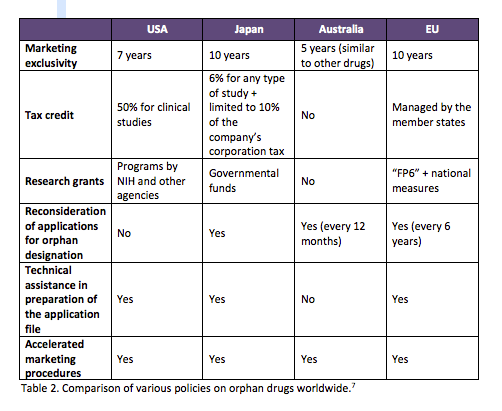
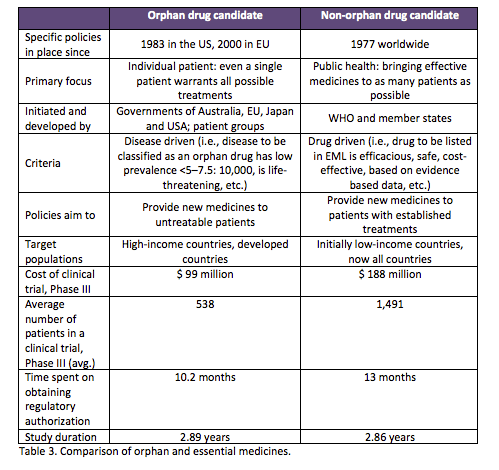
According to EvaluatePharma®, in 2014 the average per patient per year cost for an orphan drug was $111,820 versus $23,331 for a non-orphan drug with life-threatening disease indication, where average and median drug prices have been increasing year on year for both orphan and non-orphan drugs since 2010.

+50% volume of sales by 2020
Pharmaceutical companies, leaders in the field of orphan drugs, have set rather ambitious development plans that should lead to an increase in sales volume from $66.2 billion in 2013 to $113.7 billion in 2020.
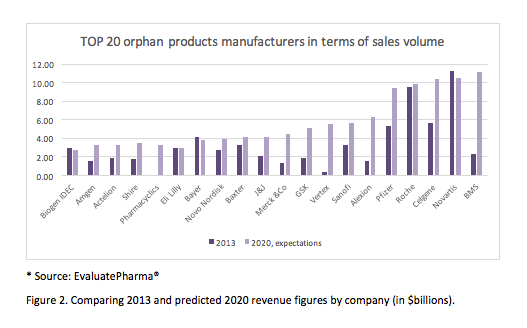
It is projected that by 2020 Bristol-Myers Squibb will become the global orphan drug market leader with $11.1 billion in sales, closely followed by Novartis with $10.5 billion in sales, and Celgene with $10.4 billion. In 2014, the FDA had issued 41 marketing permits for innovative orphan medicinal products, and the European Medicines Agency (EMA) recommended for approval the greatest number of orphan products to date, with 17 of 82 medicinal products for human use being intended to treat patients with rare diseases. 2014 became the most productive of the last 18 years, with a record number of approved innovative products by FDA and EMA. According to Reuters, orphan drugs comprised almost 40% of the new medicinal products approved by the FDA in 2014.
Top 10-selling orphan products by 2020
It is expected that by 2020, Revlimid will become the world’s top-selling orphan medicine, with estimated sales of $10 billion.9 This Celgene blockbuster was first approved in late 2005 for the orphan treatment of myelodysplastic syndrome. Revlimid was subsequently approved for the treatment of multiple myeloma and remains in development for a number of other orphan conditions. BMS’s Opdivo, which was was first approved for melanoma and is now designated for Hodgkin lymphoma, small cell lung cancer, hepatoma, and glioblastoma, is likely to take the second place with $8.2 billion in worldwide sales.10
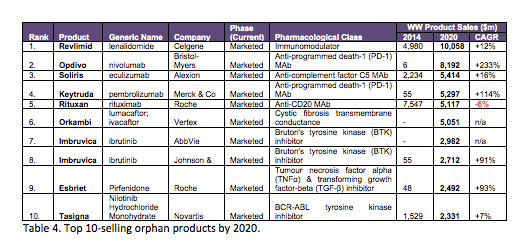
Orphan disease management in Europe
In Europe, national compassionate use (CU) programs are available on a named patient basis or to a cohort of patients.
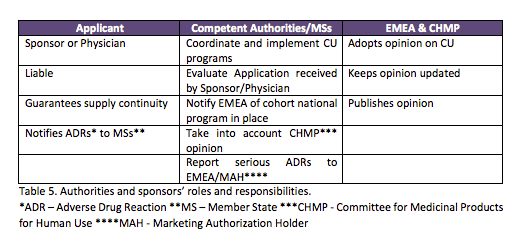
Orphan disease management in other developed markets
USA: Treatment /emergency investigational new drug (IND)
Treatment IND allows the use of an investigational drug (and biologic and devices) in patients not in the clinical trials.
Canada: Special access program (SAP)
The SAP provides access to non-marketed drugs and medical devices for physicians treating patients with serious or life-threatening conditions when conventional therapies have failed, are unsuitable, or unavailable.
Australia: Special Access Scheme (SAS)
The SAS refers to arrangements which provide for the import and/or supply of an unapproved therapeutic good for a single patient, on a case-by-case basis.
12
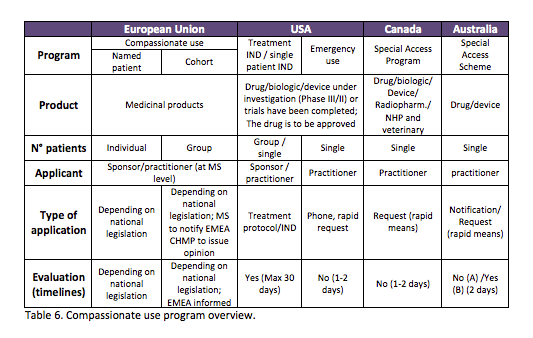
Orphan disease management in Russia
In Russia, applications for orphan designations are reviewed by the dedicated board within the Ministry of Healthcare of the Russian Federation or by the Committee on Orphan Medicinal Products, which is analogous to structural subdivision of the EMA.14 A medicinal product can be designated as an orphan drug either during preclinical studies based on its biological effects or during clinical trials if it is being studied in an orphan indication. Orphan designation does not mean that the drug can be used for treatment of corresponding rare disease. First, the manufacturer needs to obtain a registration certificate (license) for the indication that confirms compliance of a new medicinal product with local efficacy, safety, and quality standards.15
The Ministry of Healthcare established two separate schedules of rare diseases. The first list encompasses 230 diseases based on its prevalence in Russia irrespective of availability of established treatments.
4
The second list consists of 24 life-threatening and progressive rare diseases with high morbidity and mortality rates that have only symptomatic treatment.
14
Due to the fact that Russia doesn’t manufacture orphan products and instead imports them, economical and accelerated registration algorithms are desperately needed.
16
To address the issue of importation of non-registered medicinal products, the named patient program (NPP) has been recently developed.
17
The main purposes of the NPP program are the following:
- Products are under development
- Patients cannot enter clinical trial
- Products are not yet marketed
- Products are marketed elsewhere
- Unmet medical need
The program can be very beneficial to patients and the sponsoring companies, where the former get potentially life-saving medicines and the latter get to introduce its products without a formal launch.15 The sponsoring company gets other important benefits that include getting information on patients’ demographics, diagnosis, disease prevalence, and previous treatment, which helps the company to understand how its drug fits into the current treatment pathway and aids in understanding of the local supply chain and of the pros and cons of the local market. Nevertheless, for the reasons that are not well understood, the on-boarding of the program has been rather anemic, and, today, only 50 monthly approvals with this designation are obtained at local Ministry of Health.
Conclusion
In recent years, orphan drugs have become a formidable R&D segment and its robust growth is expected to continue. With a set of rather complex and specific issues that pertain to development of orphan drugs combined with difficulty in recruiting appropriate patient populations, the expansion of clinical research internationally is often needed. It is, therefore, important to understand local regulations that apply to rare diseases and orphan medicines and to utilize this knowledge effectively. Russia is an untapped territory when it comes to rare disease research and the utilization of its NPP is still in its infancy, which translates into a tremendous opportunity for orphan drug developers.
Ilya Kurdyumov, PhD, is Head of Warehouse, COREX Clinical Logistics
References
- Orphan Drug Regulations: Regulatory History. http://www.fda.gov/ForIndustry/DevelopingProductsforRareDiseasesConditions/HowtoapplyforOrphanProductDesignation/ucm356481.htm
- “What is an Orphan Drug?”, Eurordis, http://www.eurordis.org/content/what-rare-disease
- Applied Clinical Trials European Summit, 2006. Overview report
- R. Yagudina, “Rare diseases - a new category in the pharmaceutical market,” online magazine KatrenStyle
- United States Food and Drug Administration. The Orphan Drug Regulations. Final rule, 57 FR 62076 21 CFR Part 316. 1992
- Assistance in development of orphan medicinal products. Eurordis, http://www.eurordis.org/ru/content/содействие-разработке-орфанных-препаратов
- Orphan drug: Development trends and strategies. Available from: http://www.ncbi.nlm.nih.gov/pmc/articles/PMC2996062/
- EvaluatePharma report, Orphan Drug Report 2014
- http://medpharmconnect.com/novosti_orfannyie_preparatyi.htm
- Opportunities in Orphan Drugs: Strategies for developing maximum returns from niche indications, Business Insights. Available from: http://www.globalbusinessinsights.com/content/rbhc0251m.pdf
- EvaluatePharma, Orphan Drug Report 2015. 3rd Edition – October 2015
- Orphan drugs in Europe. http://www.orpha.net/consor/cgi-bin/Education_AboutOrphanDrugs.php?lng=EN&stapage=ST_EDUCATION_EDUCATION_ABOUTORPHANDRUGS_EUR
- Orphan drug: Development trends and strategies. Aarti Sharma, Abraham Jacob, Manas Tandon, and Dushyant Kumar. J Pharm Bioallied Sci. 2010 Oct-Dec; 2(4): 290–299.
- Е. Stashevskaya, Orphan diseases and their treatment. A list of orphan diseases http://fb.ru/article/174397/orfannoe-zabolevanie-i-ego-lechenie-perechen-orfannyih-zabolevaniy
- Rare diseases: why can't medicinal products be provided to patients. Review of medicine № 5, 2014
- A burden of rare disease, Medical Newspaper, № 16, Science and practice
- P.V. Novikov, “Regulatory aspects of rare (orphan) diseases in Russia and around the world,” «MEDICINE» № 4, 2013
How Digital Technology and Remote Assessment Strategies Can Aid Clinical Trial Research
July 24th 2020While there's been hopeful news on treatments and vaccines, sponsors should plan to discuss necessary strategies and contingencies at the outset of new studies or re-opening of halted studies during the COVID-19 pandemic.